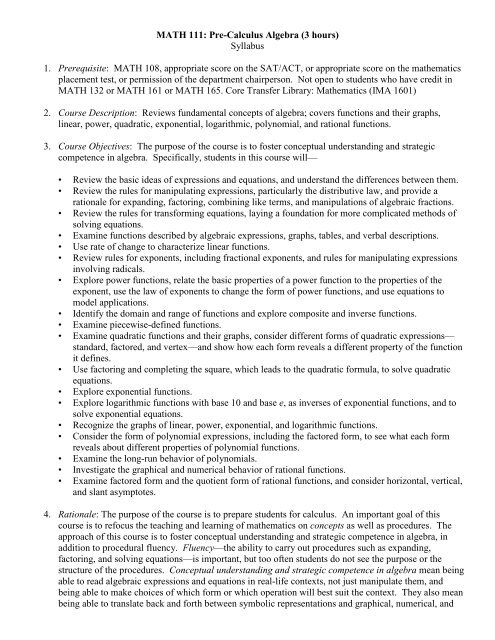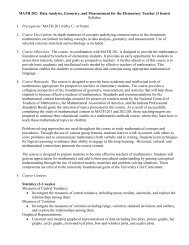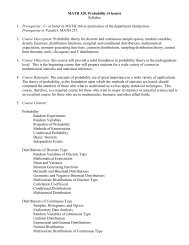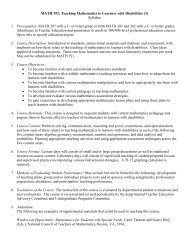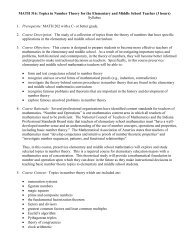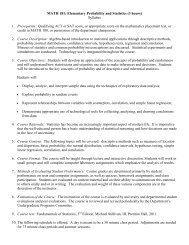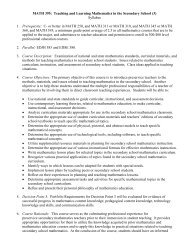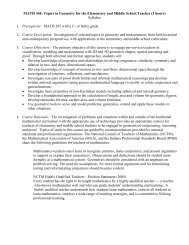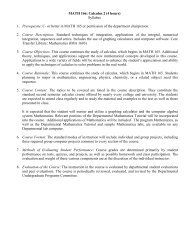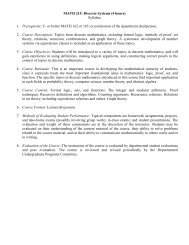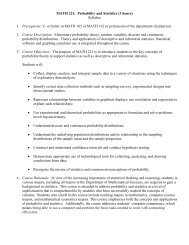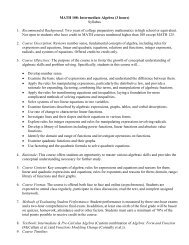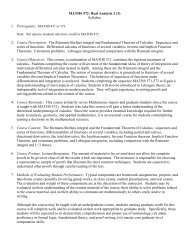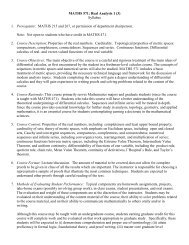MATHS 111: Pre-Calculus Algebra (3 hours)
MATHS 111: Pre-Calculus Algebra (3 hours)
MATHS 111: Pre-Calculus Algebra (3 hours)
You also want an ePaper? Increase the reach of your titles
YUMPU automatically turns print PDFs into web optimized ePapers that Google loves.
MATH <strong>111</strong>: <strong>Pre</strong>-<strong>Calculus</strong> <strong>Algebra</strong> (3 <strong>hours</strong>)<br />
Syllabus<br />
1. <strong>Pre</strong>requisite: MATH 108, appropriate score on the SAT/ACT, or appropriate score on the mathematics<br />
placement test, or permission of the department chairperson. Not open to students who have credit in<br />
MATH 132 or MATH 161 or MATH 165. Core Transfer Library: Mathematics (IMA 1601)<br />
2. Course Description: Reviews fundamental concepts of algebra; covers functions and their graphs,<br />
linear, power, quadratic, exponential, logarithmic, polynomial, and rational functions.<br />
3. Course Objectives: The purpose of the course is to foster conceptual understanding and strategic<br />
competence in algebra. Specifically, students in this course will—<br />
• Review the basic ideas of expressions and equations, and understand the differences between them.<br />
• Review the rules for manipulating expressions, particularly the distributive law, and provide a<br />
rationale for expanding, factoring, combining like terms, and manipulations of algebraic fractions.<br />
• Review the rules for transforming equations, laying a foundation for more complicated methods of<br />
solving equations.<br />
• Examine functions described by algebraic expressions, graphs, tables, and verbal descriptions.<br />
• Use rate of change to characterize linear functions.<br />
• Review rules for exponents, including fractional exponents, and rules for manipulating expressions<br />
involving radicals.<br />
• Explore power functions, relate the basic properties of a power function to the properties of the<br />
exponent, use the law of exponents to change the form of power functions, and use equations to<br />
model applications.<br />
• Identify the domain and range of functions and explore composite and inverse functions.<br />
• Examine piecewise-defined functions.<br />
• Examine quadratic functions and their graphs, consider different forms of quadratic expressions—<br />
standard, factored, and vertex—and show how each form reveals a different property of the function<br />
it defines.<br />
• Use factoring and completing the square, which leads to the quadratic formula, to solve quadratic<br />
equations.<br />
• Explore exponential functions.<br />
• Explore logarithmic functions with base 10 and base e, as inverses of exponential functions, and to<br />
solve exponential equations.<br />
• Recognize the graphs of linear, power, exponential, and logarithmic functions.<br />
• Consider the form of polynomial expressions, including the factored form, to see what each form<br />
reveals about different properties of polynomial functions.<br />
• Examine the long-run behavior of polynomials.<br />
• Investigate the graphical and numerical behavior of rational functions.<br />
• Examine factored form and the quotient form of rational functions, and consider horizontal, vertical,<br />
and slant asymptotes.<br />
4. Rationale: The purpose of the course is to prepare students for calculus. An important goal of this<br />
course is to refocus the teaching and learning of mathematics on concepts as well as procedures. The<br />
approach of this course is to foster conceptual understanding and strategic competence in algebra, in<br />
addition to procedural fluency. Fluency—the ability to carry out procedures such as expanding,<br />
factoring, and solving equations—is important, but too often students do not see the purpose or the<br />
structure of the procedures. Conceptual understanding and strategic competence in algebra mean being<br />
able to read algebraic expressions and equations in real-life contexts, not just manipulate them, and<br />
being able to make choices of which form or which operation will best suit the context. They also mean<br />
being able to translate back and forth between symbolic representations and graphical, numerical, and
verbal ones. The goal is to bring students’ understanding of mathematics to a higher level. The focus<br />
on interpreting algebraic form, supported by graphical and numerical representations, enables students to<br />
obtain a deeper understanding of the mathematics (McCallum, Connally, Hughes-Hallett, et al., 2010).<br />
5. Course Content: Key concepts of algebra; rules for expressions and equations and reasons for them;<br />
linear, power, quadratic, exponential and logarithmic functions, expressions, and equations; rules for<br />
exponents and reasons for them; domain, range, composing and decomposing functions, inverse<br />
functions, piecewise-defined functions; functions and their graphs; polynomial and rational functions.<br />
6. Course Format: The course format is typically lecture and discussion. Students are expected to attend<br />
class regularly, participate in class discussion, read the text, and complete assigned homework.<br />
7. Methods of Evaluating Student Performance: Student performance is measured by three one-hour<br />
exams, with each worth 100 points, and a departmental final exam worth 160 points. In addition, each<br />
instructor is responsible for 100 points based on quizzes, homework, attendance and/or other factors.<br />
8. Textbook: Intermediate & <strong>Pre</strong>-<strong>Calculus</strong> <strong>Algebra</strong> (Custom combination of <strong>Algebra</strong>: Form and Function<br />
(McCallum et al.) and Functions Modeling Change (Connally et al.). Suggested order of Topics:<br />
<strong>Algebra</strong>: Form and Function—Chapters 1, 2, 3, 4<br />
Functions Modeling Change—Chapter 1<br />
<strong>Algebra</strong>: Form and Function—Chapters 6, 7, 8, 9<br />
Functions Modeling Change—Chapters 2, 4, 5,<br />
<strong>Algebra</strong>: Form and Function—Chapters 12, 13<br />
[Summer 2011: R. Bremigan, K. Roebuck, R. Rufatto, S. Stump, & E. Whittern; Summer 2012: Freshman<br />
Sequence, R. Rufatto, Chair; Fall 2014, UPC, R. Pierce, Chair]


